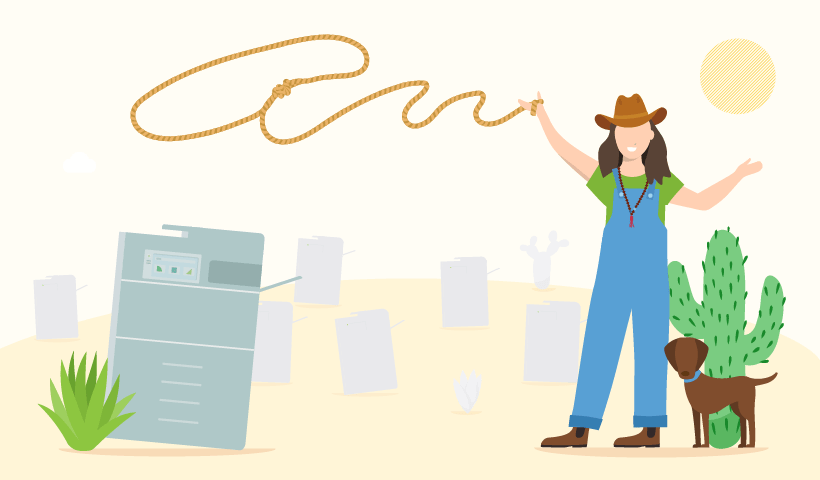Sick of racing to the printer to collect your documents? Wish there was a magic way for your print jobs to only release when you were ready?
You’re in luck.
Thanks to a room full of wonderful print geeks, pull printing exists. It’s also known by a bunch of other names: push printing; follow printing; tap and print; badge printing.
No matter what you call it, pull printing by any other name would print as sweet.
But to pull print or not to pull print? That is the question…
What is pull printing?
Pull printing is a program that enables users to print to a single print queue and collect their print job from any device.
Instead of printing directly from one device to one printer, with pull printing, printouts are sent to a single, virtual, site-wide, secure hold and release queue, patiently awaiting release. Users then release the print job from the printer of their choice.
But that doesn’t mean you indiscriminately shotgun your print job to every printer in your organization. The document is available at all eligible printers, then once it’s been collected by the user it leaves the print release queue.
It’s essentially the magic way of printing you’ve been seeking. Press print, and head to the closest printer.
Why is pull printing important?
Pull printing transforms printing as you’ve previously known it. Instead of your printing being a painful experience, it becomes a simple and harmonious business workflow.
Pull printing increases business productivity, forms another level of document security, cuts costs of print-related consumables, eliminates waste, and reduces support tickets for IT teams.
In summary, it simplifies printing for your workforce.
6 advantages of pull printing
1. Print security
Pull printing is a form of secure print release. In order for a document to print, the end-user needs to authenticate at the MFD/printer. This eliminates the risk of print jobs being forgotten or left behind at the printer.
Your organization can rest well knowing no confidential documents are sitting in the printer tray or floating around to be picked up by the wrong hands.
2. Waste reduction
Without pull printing, users can absent-mindedly press print and never retrieve their document. Or they may get sidetracked before they collect their print job. A lot can happen between pressing print and picking up a printout at the collection tray.
Pull printing stops your recycling bin from overflowing with forgotten or unnecessary print jobs. Fewer pages printed equals fewer trees cut down for paper production, making your printing a Forest Positive force for the planet.
3. Individual printers begone
Some organizations have users who demand their own local printers so that their sensitive documents are never at risk of being forgotten or picked up by somebody else.
Pull printing means your shared printers are secure, so no need for the expense of individual A4 printers on desks.
With pull printing, every shared MFD is essentially every user’s personal printer because their hold and release queue only answers to their ID authentication.
4. Ease of use
Users expect printing to be simple. Pull printing delivers the no-hassle user experience your workforce expects. Pressing print doesn’t mean you have to run to your selected printer before someone else can get their mitts on your sensitive document.
You also don’t have to schedule your workday around when you can get to the printer. Print when you want and where you want with pull printing functionality.
Think of it like this: when a user presses print a little print job shadow floats above them and follows them to whichever printer they walk to.
It doesn’t matter where your user goes, the print job will find them. That’s why our pull-printing feature is called Find-Me printing .
5. Cut costs
15% of print jobs that enter a hold/release queue never print. Pull printing doesn’t just eliminate waste, it saves you money on ink, toner, paper, and even electricity.
Less forgotten print jobs mean fewer print jobs printed twice which instantly reduces your monthly bill for printer supplies.
6. Save IT time
IT workers and system administrators the world over find printing painful. Pull printing doesn’t just create convenience for your end-users, it’s also a singular print queue utopia for IT teams.
Pull printing means there’s just one queue for sysadmins to manage. They don’t need to waste their time mapping and compartmentalizing multiple print queues for every floor, campus, or building for your organization.
They simply share one print queue and their printing-related support tickets almost disappear.
4 pull printing authentication methods
Secure pull printing rests on authentication. There are multiple ways users can authenticate their identity to release their print documents:
- Web-browser
- Card/badge/fob
- Username and password/PIN
- Mobile device
For an extra level of security, your system administrator can configure two-factor authentication (2FA). You’ll have seen this used by the likes of Google and Apple. In order to validate your identity, you must provide two forms of identification (i.e. a combination of any two of the above authentication methods).
Find-Me printing with PaperCut
Find-Me printing is PaperCut’s pull printing feature. Our print management solutions include a universal print driver, making your pull printing experience consistent no matter what device your users are printing from or what printer they’re retrieving their documents from.
Our Find-Me printing feature (available in all our main products) works on any printer model. There are no compatibility concerns, and it also forms part of your overall print management solution.
Find-Me printing can be used in tandem with other PaperCut print management solutions:
- Print Deploy | Designed to automatically push drivers and queues to multiple zones
- PaperCut Mobility Print | Enables printing from any mobile, laptop, or BYO device
Find-Me printing creates more convenience for your users than a standard pull printing feature, and is available in PaperCut MF, PaperCut NG, and PaperCut Hive.




